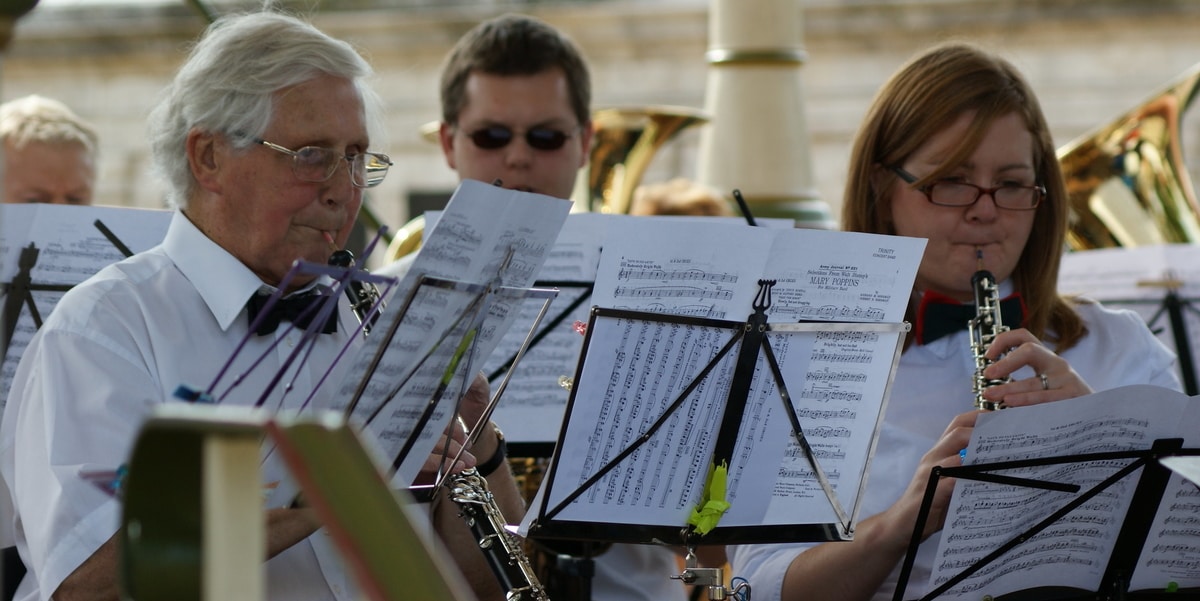So you are looking at purchasing an oboe - how exciting!
Let's talk about the things you need to know before purchasing an instrument, and what brands are recommended for all levels of oboists.
Things to Keep in Mind When Choosing an Oboe
Deciding on what instrument to get can be extremely overwhelming and confusing.
It's important to have as much information as possible so that you can make the best purchase for you or your student.
So what are the things that you should keep in mind when purchasing an instrument?
You want something that is going to last. I would not recommend buying a beginning oboe, because it won't last more than sixth months of playing without limitations.
Instruments are expensive. You do not want to be heading back to buy a new oboe six months to a year after buying your first instrument.
Intermediate oboes are solid instruments to start on that give you the most bang for your buck.
Intermediate oboes typically have the following two features that are essential in any oboe: Low Bb Key and Left Hand F Key.
I would strongly advise against getting an instrument that doesn't have these two features.
In order to get a low Bb out, you don't want to cover a couple of holes with your knees (yes, that is a real thing in beginning oboes). The sound quality severely diminishes, and the function isn't really what it needs to be.
The non-negotiable key in my opinion is a Left Hand F key. This key is arguably one of the most important ones on the instrument.
Oftentimes in beginning band method books, Forked F is introduced as the standard. That is not actually the case, as Regular F is what creates the best tone quality and intonation for the oboe.
Forked F takes the oboe outside of it's normal timbre and generally plays out of tune. However, it is very convenient for getting from C#, D, and Eb.
Left Hand F creates the best of both worlds, as the key pushes down all of the same tone holes as Regular F. It also frees up your right hand to move to the notes listed above.
If there is one thing on your list for buying an oboe, this should be it.
There are a few other things to keep in mind when choosing an oboe, such as what type of material it is made out of, etc.
Here are a couple of videos of professionals doing reviews on oboes. Both videos do a great job of explaining different features of oboes, which is why I have included the links in this article.
At the very least, it should give you a basic understanding of terms used to describe certain things on an oboe, which should take away some of the anxiety of making a large purchase like an instrument.
Check out this video by Erin Oft, with guest Erica Howard who is the principal oboist of the Atlanta Ballet:
This next video by Kessler & Sons Music takes a little bit more of an educator perspective:
Now onto the top five oboe brands (in no particular order). The following brands are all reputable oboe makers that are sure to give you quality instruments.
F Loree
F Loree is considered to be one of the finest oboes in the world; its founder introduced the Conservatory system that is now used today.
The Conservatory system includes low Bb, left-hand F, third octave key, Bb vent, forked-F resonance, split ring D#-E trill, G#-A trill, articulated B-C# mechanism, a banana key, and Bb-B trill.
The Loree oboes produce a beautiful, dark tone that is even in scale. You can choose from the Standard or AK (American) bore.
Popular in North America, the AK bore crafted into the Loree professional oboe is slightly more conical than the Standard bore, rendering it narrower near the top and slightly wider at the bell. The resulting oboe sound is focused and dark, with less edge.
Here is a brief example of someone playing an F. Loree oboe:
I would highly recommend doing some extra research to hear many examples of what these instruments sound like, which is what I recommend for every brand of oboe.
Yamaha
Yamaha makes a very good intermediate oboe. Whether you are purchasing for yourself or are a band director looking to buy a new oboe, look no further for a durable, long-lasting instrument.
Yamaha's Intermediate oboe is made from the finest-quality aged and seasoned grenadilla wood.
It has a modified conservatory system, with semi automatic octave keys, left-hand F key, forked F resonance keys, and silver plated nickel silver keys.
The instrument would be great for beginners, because it would last well through the intermediate stage of playing the oboe. The Yamaha oboes are known for their durability.
To hear an example of a Yamaha Intermediate model, refer back to the Kessler video.
Fox
The Fox Renard 330 is a high-quality plastic resin, full conservatory instrument with the exception of the split ring Eb-E trill key.
Extra features include: Nickel silver keys with 18% nickel silver hinge tubing and heavy silver-plating; Teflon-tipped stainless steel adjusting screws; silver-plated posts, bands, and bell ring.
As a plastic oboe, it has an exceptionally rich sound and will also stand the test of time. This is a great instrument for beginners that will also last into the intermediate years of playing.
Howarth
Howarth of London was founded in 1948, and produces many stunning instruments that are played by professionals all around the world.
Their selection is wide in the features you can have on an instrument. Along with Loree, I would consider these to be top-tier oboes.
This is the type of instrument that is a "forever instrument." While they are definitely an investment (as are all instruments), Howarth oboes are definitely worth it.
They have a very smooth, dark, round sound that is very sought after in an oboe. It is a reliable instrument that will last a long time.
To hear an example of a Howarth oboe, check out this video by Richard Craig Woodwind:
Marigaux
Another beloved oboe brand by professional musicians all around the world is Marigaux .
Marigaux oboes are for the oboe player who favors a dark, mellow tone.
One of Mariqaux's most popular models, the Marigaux 901, possesses a sharper, easier responding low register, and an even high register.
It is crafted from rigorously selected Grenadilla wood and silver plated, nickel silver keys, the 901 represents the very heart and essence of Marigaux manufacturing.
The Marigaux oboes sound effortless and round. After all, it is played by many well known oboists worldwide.
To hear an example of a Marigaux oboe, check out this video by Richard Craig Woodwind:
Closing Thoughts
In general, I would focus on the features like certain keys and what the instrument is made out of when choosing an instrument.
The descriptions of tone given by players hold some water, however certain instruments work better for certain players based on individual anatomy, etc.
You might feel more comfortable on a Yamaha than an F. Loree, or a Howarth more than a Marigaux. Something as simple as a reed change could also change the way you feel about an instrument.
You have to find the right combination of oboe make and oboe reed - there isn't one right answer that works across the board.
When choosing an instrument, please play test multiple instruments and brands. That will give you the most information to make an educated decision.
After testing out multiple different instruments, you know how the instrument reacts with your anatomy and reed type that you use.
This is the best thing you can do for yourself when you are making as large of a purchase as an instrument.
In later articles, I will go more in depth on specific models of instruments, so that you have more specific information about the pros and cons of certain makes.
Finding an instrument is all about finding what fits your individual voice as a player. That's the beauty of music, finding the tools and honing the abilities to communicate your individual voice and take on interpretation of the music.








